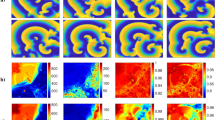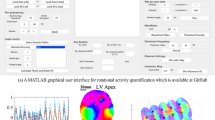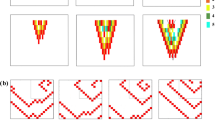Abstract
Cardiac fibrillation (spontaneous, asynchronous contractions of cardiac muscle fibres) is the leading cause of death in the industrialized world1, yet it is not clear how it occurs. It has been debated whether or not fibrillation is a random phenomenon. There is some determinism during fibrillation2,3, perhaps resulting from rotating waves of electrical activity4,5,6. Here we present a new algorithm that markedly reduces the amount of data required to depict the complex spatiotemporal patterns of fibrillation. We use a potentiometric dye7 and video imaging8,9 to record the dynamics of transmembrane potentials at many sites during fibrillation. Transmembrane signals at each site exhibit a strong periodic component centred near 8 Hz. This periodicity is seen as an attractor in two-dimensional-phase space and each site can be represented by its phase around the attractor. Spatial phase maps at each instant reveal the ‘sources’ of fibrillation in the form of topological defects, or phase singularities10, at a few sites. Using our method of identifying phase singularities, we can elucidate the mechanisms for the formation and termination of these singularities, and represent an episode of fibrillation by locating singularities. Our results indicate an unprecedented amount of temporal and spatial organization during cardiac fibrillation.
This is a preview of subscription content, access via your institution
Access options
Subscribe to this journal
Receive 51 print issues and online access
$199.00 per year
only $3.90 per issue
Buy this article
- Purchase on Springer Link
- Instant access to full article PDF
Prices may be subject to local taxes which are calculated during checkout




Similar content being viewed by others
References
Myerburg, R. J. et al. in Cardiac Electrophysiology, From Cell to Bedside (W. B. Saunders, Philadelphia, (1990)).
Garfinkel, A. et al. Quasiperiodicity and chaos in cardiac fibrillation. J. Clin. Invest. 99, 305–314 (1997).
Witkowski, F. X. et al. Evidence for determinism in ventricular fibrillation. Phys. Rev. Lett. 75, 1230–1233 (1995).
Gray, R,. A., et al. Mechanisms of cardiac fibrillation. Science 270, 1222–1223 (1995).
Ikeda, T. et al. Mechanism of spontaneous termination of functional reentry in isolated canine right atrium. Circulation 94, 1962–1973 (1996).
Lee, J. J. et al. Reentrant wavefronts in Wiggers' stage II ventricular fibrillation. Circ. Res. 78, 660–675 (1996).
Salzberg, B. M., Davila, H. V. & Cohen, L. B. Optical recordings of impulses in individual neurons of an invertebrate central nervous system. Nature 246, 508–509 (1973).
Davidenko, J. M., Pertsov, A. M., Salomonsz, R., Baxter, W. T. & Jalife, J. Stationary and drifting spiral waves of excitation in isolated cardiac muscle. Nature 355, 349–351 (1991).
Pertsov, A. M., Davidenko, J. M., Salomonsz, R., Baxter, W. T. & Jalife, J. Spiral waves of excitation underlie reentrant activity in isolated cardiac muscle. Circ. Res. 72, 631–650 (1993).
Winfree, A. T. When Time Breaks Down. (Princeton Univ. Press, (1987)).
Winfree, A. T. Scroll-shaped waves of chemical activity in three dimensions. Science 181, 937–939 (1973).
Goldbeter, A. Mechanism for oscillatory synthesis of cAMP in Dictyostelium discoideum. Nature 253, 540–542 (1975).
Lechleiter, J., Girdad, S. & Peralta, E. Spiral calcium wave propagation and annihilation in Xenopus laevis oocytes. Science 252, 123–125 (1991).
Gray, R. A. et al. Non-stationary vortex-like reentry as a mechanism of polymorphic ventricular tachycardia in the isolated rabbit heart. Circulation 91, 2454–2469 (1995).
Winfree, A. T. Electrical turbulence in three-dimensional heart muscle. Science 266, 1003–1006 (1994).
Moe, G. K. & Abildskov, J. A. Atrial fibrillation as a self-sustaining arrhythmia independent of focal discharge. Am. Heart J. 58, 59–70 (1959).
Allessie, M. A., Lammers, W., Bonke, F. I. M. & Hollen, J. in Cardiac Electrophysiology and Arrhythmias 265–275 (Grune and Stratton, Orlando, (1985)).
Krinsky, V. I. Mathematical models of cardiac arrhythmias (spiral waves). Pharmacol. Ther. B 3, 539–555 (1978).
Zykov, V. S. Simulation of Wave Processes in Excitable Media. (University Press, New York/Manchester, (1987)).
Gray, R. A. & Jalife, J. Spiral waves and the heart. Int. J. Bifurc. Chaos 6, 415–435 (1996).
Bayly, P. V. et al. Efficient electrode spacing for examining spatial organization during ventricular fibrillation. J. Cardiovasc. Electrophysiol. 4, 533–546 (1993).
Bove, R. T. & Dillon, S. M. Anew high performance system for imaging cardiac electrical activity. Circulation 94, I–714 (1996).
Cha, Y. M., Birgersdotter-Green, U., Wolf, P. L., Peters, B. B. & Chen, P. S. The mechanism of termination of reentrant activity in ventricular fibrillation. Circ. Res. 74, 495–506 (1994).
Glass, L. & Mackay, M. C. From Clocks to Chaos (Princeton Univ. Press, (1988)).
Agladze, K. I. & Krinsky, V. I. Multi-armed vortices in an active chemical medium. Nature 296, 424–426 (1982).
Fast, V. G. & Pertsov, A. M. Drift of a vortex in the myocardium. Biophysics 35, 489–494 (1990).
Gotoh, M. et al. Cellular graded responses and ventricular vulnerability to reentry by a premature stimulus in isolated canine ventricle. Circulation 95, 2141–2154 (1997).
Gray, R. A., Ayers, G. & Jalife, J. Video imaging of atrial defibrillation in the sheep heart. Circulation 95, 1038–1047 (1997).
Takens, F. in Dynamical Systems and Turbulence (eds Rand, D. A. & Young, L. S.) Lecture Notes in Mathematics 898, 366–381 (Springer, Berlin, (1981)).
Fitzhugh, R. Impulses and physiological states in theoretical models of nerve membrane. Biophys. J. 1, 445–446 (1961).
Acknowledgements
We thank O. Berenfield, Z. Silverman, J. Jiang and M. Flanagan for technical assistance and M. Vinson for reading the manuscript. This work was supported by grants from the Whitaker Foundation and the N.I.H.
Author information
Authors and Affiliations
Corresponding author
Rights and permissions
About this article
Cite this article
Gray, R., Pertsov, A. & Jalife, J. Spatial and temporal organization during cardiac fibrillation. Nature 392, 75–78 (1998). https://doi.org/10.1038/32164
Received:
Accepted:
Issue Date:
DOI: https://doi.org/10.1038/32164
This article is cited by
-
Phase Gradient Divergence for the Quantitative Detection of Focal Activation Events During Cardiac Fibrillation
Journal of Medical and Biological Engineering (2023)
-
Impact of noise on the instability of spiral waves in stochastic 2D mathematical models of human atrial fibrillation
Journal of Biological Physics (2023)
-
Complexity analysis of electrical activity during endocardial and epicardial biventricular mapping of ventricular fibrillation
Journal of Interventional Cardiac Electrophysiology (2023)
-
Non-monotonous dose response function of the termination of spiral wave chaos
Scientific Reports (2022)
-
Millimetre-scale magnetocardiography of living rats with thoracotomy
Communications Physics (2022)
Comments
By submitting a comment you agree to abide by our Terms and Community Guidelines. If you find something abusive or that does not comply with our terms or guidelines please flag it as inappropriate.



